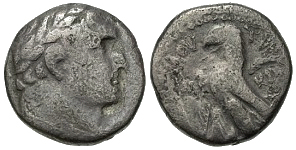| Judas' 30 Pieces of Silver - Matthew 26:14-15 |
"Then one of the 12, called Judas Iscariot, went unto the chief priests, and said unto them, 'What will ye give me, and I will deliver him unto you?' And they covenanted with him for 30 pieces of silver." -- Matthew 26:14-15. Shekels of Tyre were the only currency accepted at the Jerusalem Temple and are the most likely coinage with which Judas was paid for the betrayal of Christ. The silver shekels and half-shekels of Tyre were minted from c. 126 B.C. until c. 57 A.D. Any coin minted prior to 34 A.D. may have circulated in Jerusalem during Jesus' lifetime.

The Temple Tax Coin, Tyre KP Type Half Shekel, Jerusalem or Tyre Mint, 14 - 15 A.D.
CRUCIFIXION YEAR COIN.
The Bible does not tell the date of the Crucifixion, but based on Biblical clues, the Jewish calendar and astronomical evidence many scholars believe it was Friday, April 3, 33 A.D.
John the Baptist began his ministry in 28 or 29 A.D. and the Gospel of John points to three separate Passovers during Jesus' ministry. Jesus was executed on the orders of Pontius Pilate, the Roman prefect of Judaea from 26 to 36 A.D. This limits the years to between 30 and 36 A.D.
John P. Meier's A Marginal Jew cites 7 April 30 A.D., 3 April 33 A.D., and 30 March 36 A.D. as astronomically possible Friday Nisan 14 dates during this period. Isaac Newton, using the crescent of the moon, determined the year was 34 A.D. but John Pratt argued that Newton made a minor computation error and 33 A.D. was the accurate answer using Newton's method. Using similar computations, in 1990 astronomer Bradley Schaefer arrived at Friday, April 3, 33 A.D. A third method, using a completely different astronomical approach (consistent with Apostle Peter's reference to a "moon of blood" in Acts 2:20) based on a lunar Crucifixion darkness and eclipse model arrives at the same date, Friday, April 3, 33 A.D.
The Bible does not tell the date of the Crucifixion, but based on Biblical clues, the Jewish calendar and astronomical evidence many scholars believe it was Friday, April 3, 33 A.D.
John the Baptist began his ministry in 28 or 29 A.D. and the Gospel of John points to three separate Passovers during Jesus' ministry. Jesus was executed on the orders of Pontius Pilate, the Roman prefect of Judaea from 26 to 36 A.D. This limits the years to between 30 and 36 A.D.
John P. Meier's A Marginal Jew cites 7 April 30 A.D., 3 April 33 A.D., and 30 March 36 A.D. as astronomically possible Friday Nisan 14 dates during this period. Isaac Newton, using the crescent of the moon, determined the year was 34 A.D. but John Pratt argued that Newton made a minor computation error and 33 A.D. was the accurate answer using Newton's method. Using similar computations, in 1990 astronomer Bradley Schaefer arrived at Friday, April 3, 33 A.D. A third method, using a completely different astronomical approach (consistent with Apostle Peter's reference to a "moon of blood" in Acts 2:20) based on a lunar Crucifixion darkness and eclipse model arrives at the same date, Friday, April 3, 33 A.D.
What was the value of the 30 pieces of silver that Judas received for betraying Jesus?
The Bible does not say what the silver pieces were. But in the writer's second mention of the sum, the writer puts the thirty pieces into a context, that of fulfillment of Old Testament prophecy (See Matt. 27:8-10). Matthew actually quotes two prophets, Jeremiah and Zechariah. Although Matthew only mentions Jeremiah by name, he may have done so because Jeremiah's pre-enacted prophesy of the purchasing of the field (Jer. 32:6-9) was the more prominent point Matthew wanted to make. The purchase of the field seems to be the major point that Matthew is making. However, Matthew also quotes Zechariah 11:12 which gives us the value for the field. In Zechariah's day, the reference to silver would undoubtedly have been to the shekel which was the standard weight for paying a price. The shekel has a long use in purchasing property, going back to Abraham's time (Gen. 23:16). In New Testament times, the shekel was the value of about four drachmas (a Greek coin) or four denarii (a Roman coin). It would be in weight a little less than half an ounce of silver. It's value as currency would be the common wages for a laboring man for four days, or in today's value perhaps around $400 to $500.
The thirty pieces of silver, then, would be worth around $12,000 to $15,000 in today's sum.
Other reads:
http://www.joankrempelministries.com/mystories/30pieces.html
http://www.newadvent.org/cathen/08539a.htm
http://www.sunstar.com.ph/davao/ledesma-judas-40-pieces-silver
http://en.wikipedia.org/wiki/Judas_Iscariot
http://www.letusreason.org/Doct48.htm




No comments:
Post a Comment